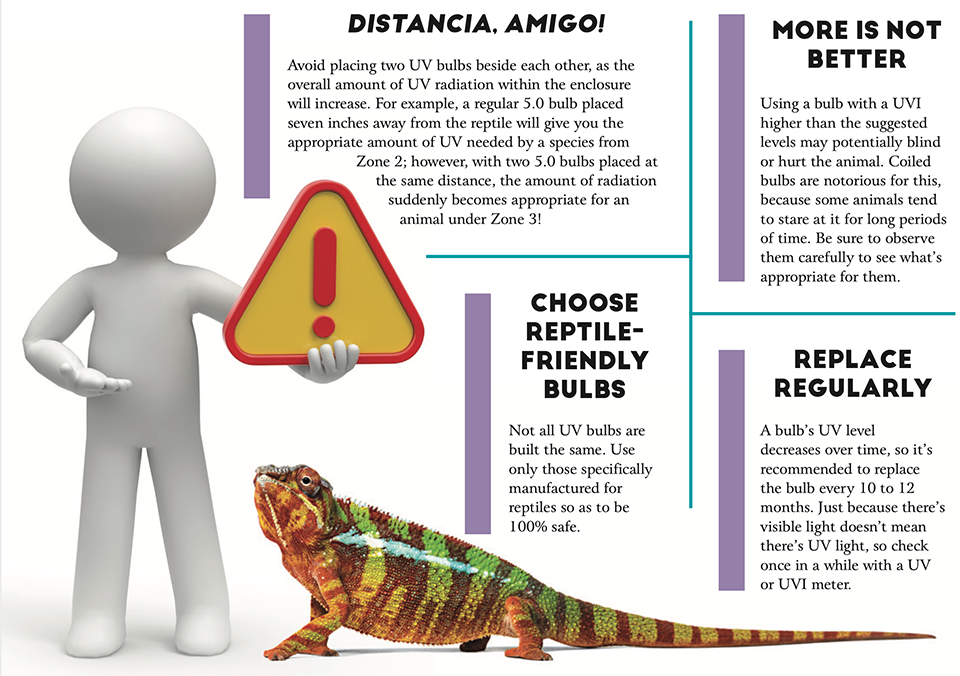3 RAYS TO APPRAISE
Ultraviolet (UV) light is a vital yet confusing element with which everyone caring for a reptile should familiarize themselves.
UV light can be divided into three categories: UVA, UVB and UVC.
UVA allows reptiles to view their environment more effectively, encourages a healthy day-night cycle, and perhaps even promotes a more naturalistic behavior.
UVB promotes the natural synthesis of vitamin D3, which helps in the regulation of phosphorus and calcium levels in their body. Vitamin D supports a healthy nervous system and prevents diseases, such as metabolic bone disease that cause painful bone deformities common among captive reptiles.
In the wild, reptiles get their vitamin D3 from the sun, but those kept indoors won’t always have the opportunity to bask outside. Luckily, there are a lot of UV bulbs made just for reptiles that are available in the market to help emulate their natural environment. However, it could be overwhelming for a beginner hobbyist to choose the right bulbs because of information overload.
UVC may cause tissue damage and is generally used for sterilizing equipment. It is not beneficial to living things.
WHAT UV BULB SHOULD ONE USE?
To help you choose a bulb that is right for the reptile you are caring for, here are a few easy questions to guide you.

WHAT IS UVI?
Ultraviolet index, or UVI, is defined by reptile brand Zoomed as the unitless measure of UV radiation. Those wavelengths are what contribute to a reptile’s ability to synthesize their own D3.
It is measured from 0 UVI to 8 UVI, sometimes more. A general rule of thumb: Reptiles that prefer darker environments or have thinner skin typically require lower levels of UVI, while those who are usually active during midday and are basking frequently need stronger levels.

UV LIGHT PLACEMENT
So let’s say you’ve determined the level of UV a reptile needs based on their species and their zone in the chart. Now, it’s time to choose a bulb and find out how to use it.
In general, you may find bulbs with UVIs of 5.0 or 10.0 and think that they’re too strong, but it’s important to remember that the farther away the animal is from the bulb, the less UV they will get.
The key is to distance the bulb in such a way that when the rays hit the animal at a certain height (preferably around their basking spot), the level of exposure remains in their suggested zone.
For example, for a bulb with a UVI reading of 5.0 to be placed 10 inches away from an animal, the actual UV the reptile receives will be at a UVI of around 0.4-0.7 only, which is suitable for crepuscular or shaded animals (those in Zone 1).
Another example is using a UVI 10.0 bulb and placing it five inches away from the animal. This would put the UVI at around 2.6-3.5, which is the UV required by midday baskers (those in Zone 4).
ULTRA IMPORTANT TIP ABOUT ULTRAVIOLET
In an enclosure, it’s always good to provide gradients, whether in terms of temperature or UV. Make sure the bulb is a certain distance away from the reptile so that the animal can retreat from the light whenever they want to. Make sure there is a gradient that goes all the way down to zero as much as possible.

UV BULB SIZES AND WATTAGES
The wattage on a UV bulb’s box pertains to the amount of electricity a bulb uses to produce light: The higher the wattage, the stronger and brighter the bulb is.

Some people think that a smaller bulb with the same UVI level that they are looking for could save them money, because it consumes less electricity. While smaller bulbs are alright for small spaces, it’s important to remember that larger enclosures need stronger and bigger bulbs, or they won’t be as effective.
Don’t try to cut corners if it’s to the detriment of a reptile. Try to provide a reptile with the right type of bulb, and set it up correctly within their enclosure.
WORDS OF CAUTION
When using UV bulbs, make sure to follow these precautions.

BEHAVIOR OVER HABITAT
Just because a reptile is found in a desert-like environment does not mean they require a desert bulb. Consider what time they’re most active or if they prefer to stay in burrows.
For example, a leopard gecko may come from a hot environment, but because they are crepuscular, they require only a low level of UV as their body absorbs it faster.
UV-BLOCKING MATERIAL
UV wavelengths can’t penetrate certain types of plastic and glass. A reptile next to a sunny window may stay warm, but they might not be getting their needed UVB.
UV IS NOT VISIBLE LIGHT
UV bulbs aren’t the same as heat bulbs. They are not supposed to provide warmth or appear extra. Their main purpose is to provide healthy levels of UV.
USE SILVER WITH CAUTION
Light domes with silver interiors may double the amount of UV levels an animal will absorb, so make sure to only use silver with larger enclosures so that the rays can spread out. For smaller enclosures, it might be best to stick to domes with white interiors.

RESEARCH REAPS REWARDS
Modern reptile equipment helps those with animal companions to provide a better living environment for the animals under their care, as long as the equipment is handled properly.
Always remember to do your research about the kind of setup you need to provide for your reptile companion, and try to replicate their natural habitat as much as possible. Most reptiles and amphibians can benefit from some level of UVB, and although some don’t need it all the time, it can boost their overall health.





